Hubbard Radio Washington DC, LLC. All rights reserved. This website is not intended for users located within the European Economic Area.
On Air: Federal News Network
Trending:
DoD spending data tells us how serious the Pentagon is about a shift to great power competition
A new analysis of contracting data by the Center for Strategic and International Studies shows some glimmers of a shift in spending priorities starting in 2019.
Best listening experience is on Chrome, Firefox or Safari. Subscribe to Federal Drive’s daily audio interviews on Apple Podcasts or PodcastOne.
The national defense strategy the Pentagon published back in 2017, emphasized a shift to great power competition – China, and new technology development. So has the DoD been putting its money where its mouth is? Well, a new analysis of contracting data by the Center for Strategic and International Studies shows some glimmers of a shift in spending priorities starting in 2019. For more, Federal News Network’s Jared Serbu spoke with the deputy director of the Center’s Defense Industrial Initiatives Group Gregory Sanders, on Federal Drive with Tom Temin.
Interview transcript:
Gregory Sanders: So it shows that it’s not what expanded believes, and they’re saying they prioritize. We see some gaps in some of the areas like electronics, comms, and sensors that are relatively high priority, but are a bit lower than [they] might otherwise be. What spending has gone for, particularly during this most recent period, there was some need on more traditional platforms and the like that are part of the priorities, but not highest end or the particular ones are emphasized in a great power competition. So there’s a little bit of a gap between the strategy and largely driven by the momentum and inertia of the system. So that would has been around for a while, still has a great deal of pull, and the attempt to move towards what’s newest and with prioritize, is slow and coming. I think one of the biggest things I note is that space systems are up. They’re up to 6.1 billion from 2018 to 7.3 billion in 2019. But on the whole space spending, which admittedly, we’re only seeing the unclassified portion of still is at a relatively minor level compared to many of these other priorities. So I would say, be aware there’s a good amount going to be classified space as it were. But that that particular portfolio, for all the talk of standing up a Space Force is still a relatively minor portion of overall contract spending.
Jared Serbu: And the paper is based primarily on 2019 spending data. So not that far into the actual effectuation of the defense strategy did some of the early numbers that you’ve seen from 2020, kind of reaffirm everything that you just said? Or are there ways in which we can start to see spending more closely aligning with the strategy starting in ’20?
Gregory Sanders: We have seen a real jump in ships and submarines that I think for some of the larger fleet goals, you can see that alignment, aircraft continue to be up. But on electronics, comms and sensors, that’s still pretty flat. And the other thing that has happened [in] 2020 was a massive jump in other transaction authority spend. But a lot of that was driven by vaccine purchase rather than defense strategy purposes.
Jared Serbu: The OTA issue brings us into R&D, which is one of the areas that jumped out at me in the report. It wasn’t that long ago when CSIS’ reporting showed some really worrying trends in the R&D space, when we were really in the sequestration trough. In 2018, it started to look like there really was a recovery underway, and 2019 really affirmed that, right?
Gregory Sanders: Right, absolutely. So while there’s a bit of the slowing of the overall pace of product spend in 2019, we see a 13% growth in R&D spending, and begins to be spread out a bit, and that spending is reinforced by what’s going on in Other Transaction Agreements. So we’re not just seeing the shift to new ways of buying, we’re seeing some firming up of the classic approaches.
Jared Serbu: And I noticed the report did kind of split apart OTA spending in that R&D discussion. Is there a reason to count that separately? Is it because we don’t know what the same fidelity within that OTA bucket if it’s all R&D?
Gregory Sanders: Yeah, there’s a bunch more information on the full gone contract spends. Part of a freedom of OTAs is there’s also a bit less reporting. And so if you look at just straight OTA spends you can see it’s nearly doubled from ’19 to 2020, but again, vaccines are a huge driver there. And it would look like you might see a fair amount of increase in some of the early stages, but it doesn’t necessarily translate. We’re also a little uncertain about how much of the middle tier of acquisition is fully going to translate into production. So I think some of where the stages are in OTA are not necessarily as firmly developed as the stages of traditional contracting.
Jared Serbu: Um, let’s talk about some of the differences between product and service growth that you found. Tell us a little bit about what you found there and how that aligns with the strategy.
Gregory Sanders: So product spending was up just 3% for 2019 versus 13% for services. Generally speaking, DoD is not excited to have a lot of growth in services. That scenario where a fair amount of constraints often start and one of the biggest drivers was actually in construction and facility-related services. So some of that is actually new facilities and other work around and I think probably some wall spending for 2019 in particular. So some of those are not necessarily the full on traditional priority areas, but some of the other services have been – and steady equipment-related services have not been rising too much, which is good as operation maintenance is generally a place where you want to control costs.
Jared Serbu: You can tell me if this characterization is wrong, but it looks like really across the board, we’re at a place where most categories of DoD spending have recovered from the sequestration days. Assuming that’s right, are there any particular areas where there’s reason to be concerned about the health of the industrial base, even in 2021? Or I should say it in 2019? Because that’s where the data is from?
Gregory Sanders: Right. So I would say that we’re still only seeing so much of a transition to – we’re seeing more of a system development on R&D, the kind of move from research to full on production. But I think that pipeline, particularly the challenges of COVID-19, to the industrial base, where very sensibly a fair number of deadlines were allowed to slip. And there’s understanding there. But ultimately, the question of how much do we successfully make the transition to production, I think is going to be one place to watch. And some of the things where you’re more dependent on the international supply chains, I think, are going to be an area to watch. But that’s not showing up as strong in the data yet at this point. We’re seeing still a more stable and vendor count. There had been a bit more of a decline in the years post budget caps, etc. So that’s stabilized. But I don’t think we’re seeing the evidence yet of really massive intake of the non-traditionals or that goal of expansion in that range.
Jared Serbu: It’s obviously going to be a while before we see exactly what the impact of the Afghanistan withdrawal has been on defense spending. But I assume at least what you can do is look at 2019 numbers, and see how much was in [overseas contingency operations] because there was still a pretty robust OCO budget at that time. Do you – can you break things out in that way and see, with the absence of that OCO spending – real OCO spending, I mean – how that might impact the trends once that spending is removed, as it now has been?
Gregory Sanders: So historically, we can’t break out OCO some. We didn’t do it in this report specifically, and [in] some other ones, and I believe it was around $10 billion, I think in real OCO, I would double check that number and get that for you in full. So I think we’re going to see that drop off some. Though the concentration in Afghanistan had been a little lower as they’ve been a bit of a drawdown there for a while. But obviously, one of the big factors that was found – withdrawal and reinforced now by what happened – was the pullback of equipment and support from the Afghan Air Force, etc. So the international services part of the industrial base, that does things that go along with foreign military sales are going to be affected. There’ll be enough of the rise of foreign military sales and some other areas that aren’t necessarily associated with OCO and more associated with either allies or partners who are in more stable situations, have been up a bit, but I think will [steadily] mitigate the impact of that on the industrial base.
Copyright © 2024 Federal News Network. All rights reserved. This website is not intended for users located within the European Economic Area.
Tom Temin
Tom Temin is host of the Federal Drive and has been providing insight on federal technology and management issues for more than 30 years.
Follow @tteminWFED
Related Stories
Two powerful chairmen criticize White House for ‘dragging its feet’ on defense spending
On DoD

WEDNESDAYS, 11 A.M. & 2 P.M.
Each week, Defense Reporter Jared Serbu speaks with the managers of the federal government's largest department. Subscribe on PodcastOne or Apple Podcasts.





